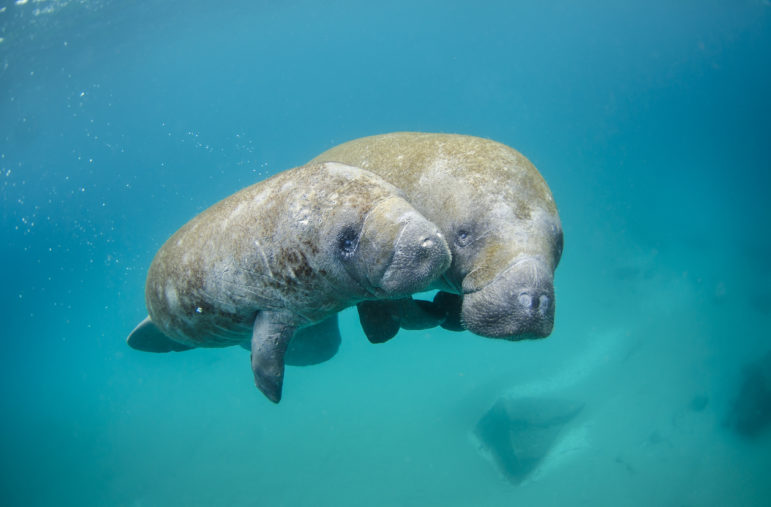TWH – The loss of seagrass has caused the death of 10% of Florida Manatees, a mass death that is concentrated in the Indian River Lagoon. Manatees gather there in the winter, and they have a sensitivity to cold.

Indian River Lagoon Map – Image credit: U.S. National Archives and Records Administration – Public Domain
The Lagoon’s warm waters attracts them. Unfortunately, about 90% of the seagrasses in that Lagoon have died. Manatees rely on seagrasses as their primary food. Pollution from “septic tanks, sewage, and fertilizer” run-off is driving this mass death. Efforts have begun to improve water quality in the Lagoon. Once, the Lagoon had lush seagrass beds. Now, it may take years to restore those beds. In human terms, manatees are suffering from a seagrass famine.
While 10% of manatees have died, 90% of several species of seagrasses have also died. That degree of loss impacts the entire ecosystem. From another perspective, a tear in the web of life has begun. Unless that tear is repaired, it will become a hole.
Before this famine, environmentalists and state wildlife officials had opposed people feeding manatees. Now, they are rethinking that opposition.
Current state and federal law, however, bars non-professionals from feeding manatees without specific permits. These restrictions have similarities to professional licensing requirements. Knowing what, and how, to feed manatees requires skills and knowledge.
Federal and state laws define feeding manatees as harassment. State law assigns a fine of $500 and/or up to 60 days in prison for that harassment. Federal law assigns a fine of $100,000 and/or one year in prison.
How does one rehabilitate a starving manatee?
As with humans, recovery from starvation is a long and complicated process. First, hunger becomes chronic. At some point, it becomes malnourishment. Sometime later, it becomes starvation.
Jon Peterson, who heads the rescue operations at Sea World, told NPR that once starvation has begun, a manatee’s stomach begins to shrink. Peterson said, “You slowly stretch the stomach, get it used to food again.”
Peterson stated that for a manatee near starvation, “We’re looking at four to nine months before they’re ready to go back out.”
Sometimes the dying manatees are mothers with calves. Peterson said that rescuers have brought in many orphaned calves. Their recovery will take three to four years. Manatees are sea mammals. In their first year, staff must bottle-feed the orphaned calves. Sea World has a success rate of 96% in returning these calves to the wild.
The Wild Hunt reached out to Save the Manatee Club for their views on the situation.
A possible path to a solution
People can seldom choose between risk and no risk. Most often, people have to compare risks and chose the lesser one. When manatees had enough to eat, the risks of humans feeding manatees outweighed any rewards. Now the greater risk is starvation.

Manatee with calf – Image credit: Sam Farkas (NOAA Photo Library) – Public Domain
The Save the Manatee Club now supports “providing manatees with limited food and water when medically indicated while monitoring the manatees’ response and body condition.”
They urge non-professionals to continue to refrain from feeding manatees on their own.
For example, in some animal care facilities, the staff give manatees lettuce and other plant foods. The staff does this in ways that avoid human-manatee interaction. They do not hand-feed the manatees. They might float the lettuce on the surface of the water, mimicking surface feeding. Alternatively, they might let the lettuce sink to the bottom, mimicking bottom feeding.
NPR reported that Florida’s Fish and Wildlife Conservation Commission has agreed to the idea of limited supplemental food assistance to manatees. As of press time, the US Fish and Wildlife Service has not yet reached this conclusion.
What is wrong with feeding manatees?
Some TWH readers may be wondering what’s wrong with feeding starving sea mammals.
The Save the Manatee Club discussed problems with the non-professional feeding of manatees. Feeding manatees carries many of the same problems that feeding any wild animals–it can cause their behavior to change and can prove dangerous or harmful for the animal.
The bodies of manatees evolved to eat specific water plants. Their bodies may be unable to digest or tolerate other foods as well.
Most seriously, feeding manatees from a boat could cause them to lose their fear of boats. Most manatees already have scars from boats crashing into them.
Save the Manatee Club noted that “Manatees have a natural fear of people and loud noises, but they can lose that fear when they associate people with a reward” such as being petted or fed.
In addition, some humans have bad intentions. The Save the Manatee Club has heard reports of people using food to attract manatees. As manatees approach, humans began toying with the sea mammals, at times with dangerous items.
What people can do

The Save the Manatee Club has suggestions for what people can do to protect and heal manatees on their website. If people want to learn how to identify an injured, starving, or orphaned manatee, they should visit this Page. For other steps to protect the manatee, people should visit this Page.
To report a suspected injured, starving, or orphaned manatee call the Florida Fish and Wildlife Conservation Commission 1-888-404-FWCC (3922).
The Wild Hunt is not responsible for links to external content.
To join a conversation on this post:
Visit our The Wild Hunt subreddit! Point your favorite browser to https://www.reddit.com/r/The_Wild_Hunt_News/, then click “JOIN”. Make sure to click the bell, too, to be notified of new articles posted to our subreddit.
